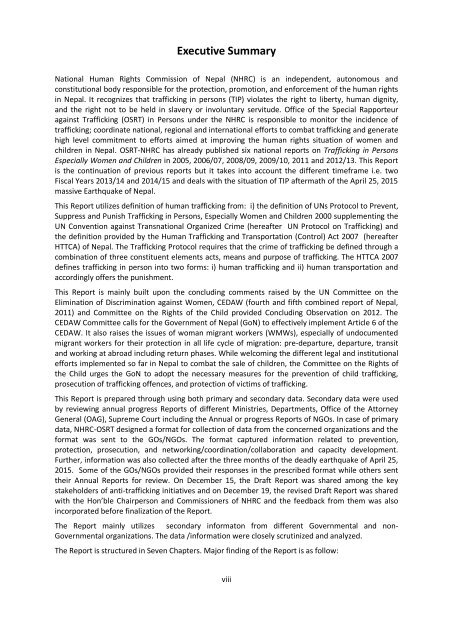TRAFFICKING IN PERSONS
397604438Trafficking_in_Persons_National_Report_2013-15
397604438Trafficking_in_Persons_National_Report_2013-15
You also want an ePaper? Increase the reach of your titles
YUMPU automatically turns print PDFs into web optimized ePapers that Google loves.
indications of the processes of trafficking: majority of victims are recruited through giving false<br />
promises and almost 90 percent of the imprisoned traffickers reported that they worked in a group.<br />
Majority of the imprisoned traffickers reported that they involved in recruitment processes and<br />
transportation, rather than selling of the victims. In majority of the cases, the traffickers crossed the<br />
border during the day and more than half confessed that they were not interrogated by anyone in<br />
the borders. Trafficking route is reported to be the main official border points between Nepal-India<br />
and Nepal-Tibet.<br />
Studies on entertainment sectors mainly initiated after 2000s when the surge of the female workers<br />
are reported to be exploited in the mushrooming number of cabin, dance restaurants in Kathmandu<br />
valley and other major towns of Nepal. Studies such as TDH, 2010; Saathi/Planete Enfant, 2014;<br />
Chhori, 2015 and WOFOWON, 2015 establish the fact that female workers in the entertainment<br />
sectors are economically cheated, exploited and vulnerable of sexual abuse, exploitation and<br />
trafficking. These entertainment sectors have become destination places for the village girls as well<br />
as source hub for the trafficking to abroad, mainly to Gulf States. Some NGOs such as Saathi, Biswas<br />
Nepal, WOFOWON, Chhori and Change Nepal are engaged with support from the Asia Foundation,<br />
TDH, Geneva Global, and Danish Embassies to promote and protect the rights of female workers in<br />
the entertainment sectors. Despite this, there is lack of consolidated data on interventions and the<br />
number female workers engaged in the various forms of entertainment sectors.<br />
Trafficking of girls to Korea and China for the purpose of marriage is a growing phenomenon in<br />
Nepal. This happens because South Korea and China have been experiencing low fertility and high<br />
son preference. The NHRC-OSRT National Report 2009/10 of TIP estimated that there are at least<br />
1,000 female migrants who went to South Korea through marriage in between 2005 and 2013.<br />
About 300 are happily married while others are in slavery like condition. On March 7, 2015, the<br />
Central Investigation Bureau (CIB), Nepal Police raided the Chheru International Pvt. Ltd., and<br />
arrested the rackets involved in trafficking of young girls to Korea and China for marriage. Initial<br />
investigations show that there are at least 83 such bureaus operating in Nepal.<br />
Another growing form of TIP is the illegally extraction of human organ – the kidney. PPR Nepal<br />
carried out a study among 36 kidney donors of Kavre district in 2014. The study found that 16 out of<br />
36 kidney donors interviewed were Dalit. In the sample of 36 kidney removal victims, 27 reported<br />
that they granted consent for the extraction of their kidneys. This is very unusual finding as nobody<br />
would be happy to sale his/her organ willingly. Economic compulsion may be the prime factor for<br />
internalization of such wrongdoings. An overwhelmingly majority of kidney donors was contacted via<br />
middle person – reflecting that kidney donors were commoditized. The kidney extraction can have<br />
far reaching consequences on the individual physical and mental health such as feeling weakness,<br />
chronic headache, and no appetite, disorder in sleeping, vomiting and impotence. As many of the<br />
victims of the kidney removal are breadwinner in the family, the result of weak physical and mental<br />
health can have adverse impact on income of the household and livelihood.<br />
Child vulnerability of trafficking is enormous in Nepal as indicated by the very high estimated<br />
number of children in child labor situation. According to the Nepal Child Labor Report 2012 (ILO,<br />
2012), 40 percent of the 7.77 million estimated number of children in Nepal are working children.<br />
Nearly 21 percent children are in the state of child labor and 8 per cent are in the state of worst form<br />
of child labor.<br />
Several forms of vulnerabilities of trafficking of girls exist in Nepal such as harmful traditional<br />
practices, child marriage, and violence against children. According to the Informal Sector Service<br />
Center (<strong>IN</strong>SEC) report in the 2013, a total of 715 children are reported to have victims of different<br />
crimes: rape alone constituted of 57 percent, followed sexual abuse (25.5%) and child trafficking<br />
(9%). This pattern also holds for the year of 2014.<br />
Studies indicated that there is linkage between trafficking and inter-country adoption. While<br />
studying the situation of inter-country adoption in Nepal in 2009, the Hague Conference on Private<br />
x


